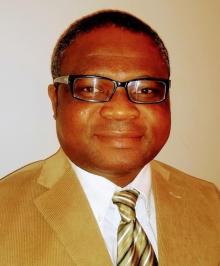
Molecular structure, function, and regulation of ion channels, transporters, and pumps; channelopathy; mitochondria and mTORopathy mediated epileptic spasms and structural epilepsies; identifying novel genes, biomarkers, Machine Learning & Artificial Intelligence tools, and early-stage therapeutic research (mechanism-of-action of compounds and ligands) for the epilepsies and other neuronal disorders.
Additional Keywords: Epilepsy therapeutics; machine learning & artificial intelligence for Epilepsy, structural biology; protein biochemistry and protein-protein interactions
Dr. George K.E. Umanah is a Program Director with a focus on the basic and translational research on the molecular structure-function relationship, regulation, and pathophysiology of ion channels, transporters, receptors, pumps, and other membrane proteins in the Channels, Synapses, and Circuits cluster. His additional interests are in research on mitochondria and MTORopathy mediated epileptic spasms and structural epilepsies, identifying novel genes and biomarkers, Machine Learning & Artificial Intelligence tools, and early-stage therapeutic research for the epilepsies and other neuronal disorders.
Dr. Umanah was an Assistant Professor of Neurology and Institute of Cell Engineering at Johns Hopkins School of Medicine. He received his Master of Research in Medical Biotechnology from the University of Essex, England. Dr. Umanah earned his Ph.D. from the University of Tennessee, Knoxville studying G-protein coupled receptor-ligand signal transduction. During his postdoctoral training in neurology at Johns Hopkins School of Medicine, he studied the mechanism of glutamate receptors mediated synaptic plasticity, epilepsy, and neurological disorders. As a faculty his research on characterizing the novel ATAD1 and other genes, and mutations associated with epilepsy was funded by NINDS and other private sources. Dr. Umanah's lab used a combination of numerous state-of-the-art techniques spanning X-ray crystallization, cryo-electron microscopy, single-cell laser capture microscopy and animal models to study protein complexes associated with neurological diseases.
